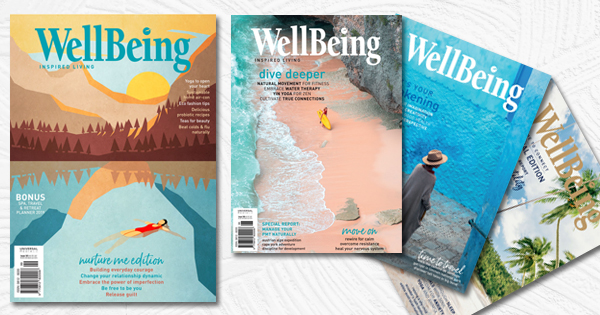The Universal Media Co has launched a Mindful Media brand, to include its existing WellBeing magazine and two new multi-platform publications: WILD and BEING. TMSN takes a look at the dynamics that allow Universal to champion print and create a commercially viable range of sister magazines.
WellBeing and its sister publication WellBeing Eat Well will continue as a bi-monthly magazines. WILD and BEING will be launched later in 2019, with WILD to be a quarterly magazine and BEING a bi-monthly magazine.
Publisher Janice Williams explains that Universal spoke with its readership between the ages of 12 and 35 about their media consumption habits.
“Are they digital? You bet. Are they visual? Completely – and with distinct preferences in sub-generational groups.
“We were looking at how communication styles have changed and we realised that generational distinctions provided an opportunity to communicate with real relevance and attentiveness.”
WILD will be targeted at Millennials and BEING will be targeted at Centennials.
Identifying the key differences
Announcing the new titles, Universal explains that WILD invites its audience to “live your wild life”. The magazine focuses on content for readers who are “establishing their lives and shaping their futures”, inspired to make decisions for a better life.
Whereas, the main message of BEING is that it is ok to “just BE”. Universal says that it is a companion for starting up, stepping out, finding your feet, falling over and doing it all again with joy and compassion.
The importance of print for mindfulness brands
Universal says that both publications provide their audiences with a rich and valuable experience of “in-mind” time.
“When we talk to these mostly digitally-native generations, it is clear they value calm, creative, thoughtful stories from sources that are credible and relatable,” says Williams.
“Their visual sensibilities are also extremely sophisticated. So while digital communications are very much a part of the picture, the print format gives us the calm, slow, reading experience that we want, with a visual packaging that is quite playful and retro-cool.
Janice Williams, Publisher, Universal Media Co
“The experience that you get with Mindful Media is derived in part from what you see on the page, and partly from what your own mind brings to the experience,” said Williams. “We wish to create beautiful reading experiences that are relaxing, thoughtful and inspiring.”
The readership split
For many publishers, investing in additional magazines covering similar topics would be seen as a bullish move. Production costs and resources increase with the risk of readership figures or advertising revenue suffering in either the existing or new publications.
However, WellBeing has enjoyed steady readership growth over a long period of time. In June 2019, Roy Morgan stated that the magazine had grown its readership by 10.5 per cent over the prior 12 month period, recording a readership of 147,000.
Announcing the news, Universal Media Co said that it “now offers 62,000 more readers than its closest competitor [Hearst Digital Media’s] Prevention…WellBeing now offers 175 per cent of the audience of Prevention.”
When you are that far ahead of your closest competitor, you can afford to play around with your readership figures. Strategically.
Niche is best
Refining WellBeing’s content within WILD and BEING allows Universal to be closer to the two sub-generational groups that make up its readership.
The FIPP insight report Proof of Performance: Making the case for magazine media states “Readers choose magazines whose personalities and interests match their own. It creates an involved trusting relationship, like a friend. This means attentive, thorough and repeated reading – often in a ‘magazine bubble’ of me-time.”
Universal are likely taking a punt that the overall readership between the two new titles will increase thanks to their refined ‘personality’.
Currently, Williams says that WILD is expected to have a readership of 85,000, and BEING a projected readership of 70,000. Still ahead of their closest competitor.
But from an advertising revenue perspective, it is unlikely to matter. Universal has created a range of sister titles with similar but unique readerships that its advertising clients can reach, adapting their marketing message to achieve the best results with each audience.
It is a win, win. A win for advertising clients, a win for Universal in maximising client value.
Universal Media Co publishes 53 niche magazine brands including special interest and B2B titles.







